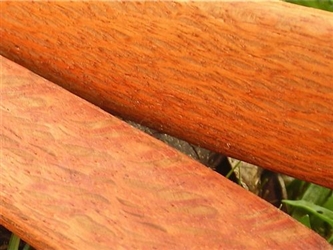 |
Lacewood
Lacewood is a hard porous exotic wood native to eastern Australia that delivers a milder tone.
Lacewood is characterized by conspicuous iridescent flecking that resemble "lace" patterns. The beautiful pink, red, and golden patterns appear even more prominently when the wood is expertly quartersawn.
The name "Lacewood" is a broad label. Virtually any wood that displays figuring which looks like lace is called Lacewood. Lacewood is prized for products that benefit from its marvelous appearance and tone qualities. The wood is below grade for industrial strength so it is not used for structural supports.
Bone Rattling Facts
Lacewood is an exotic tonewood used in the manufacture of musical instruments including drum sticks, organ pipes, piano keys, pianos, sounding boards, violin bows and xylophones.
An article in Mel Bay's Webzine, "Guitar Sessions" by J. Chris Herrod of Luthiers Mercantile International reports that "outside of the mahogany species, lacewood is the most exciting [tonewood] alternative." He goes on to say that "according to John Greven, a luthier who has built hundreds of guitars in his career and who has a great respect for vintage Martins, lacewood has the rare ability to impart the tone of a well-aged Martin mahogany guitar."
Cool Facts
-
Lacewood is native to Australia but is now grown extensively around the globe.
-
Lacewood provides shade for coffee and tea plantations.
-
Lacewood is a popular ornamental tree.
-
The name "Lacewood" is a descriptive title that has been appropriated by several species of woods.
Figures below are approximate (but pretty darn close)
Tonality
Can't Decide Which Bones to Choose?
Check out this handy guide: Bone FAQs
Scroll down for technical Lacewood facts...
|
|
Lacewood Facts
Scientific Name
Cardwellia sublimis (Northern Australia, Queensland)
aka:
Grevillea robusta (Southern Australia, Africa, India, Sri Lanka)
Panopsis Platanus
Panopsis rubescens (Para, Brazil)
Platanus acerifolia (UK)
Platanus hybrida (UK)
Roupala braziliensis (Brazil)
Roupala Cardwellia
Other Names
Australian Silky Oak (Cardwellia sublimia)
Brazilian Lacewood (Roupala braziliensis)
Bull oak
English plane (Platanus hybrida) UK
European plane (Platanus hybrida) UK
French plane (Platanus hybrida)
Golden spangle wood
Harewood UK
Leopardwood (Panopsis rubellens) Brazil
London plane (Platanus hybrida) UK
Louro faia
Northern Silky Oak (Cardwellia sublimia)
Queensland Silky Oak (Cardwellia sublimia)
Selena (Cardwellia sublimia)
Seleno (Cardwellia sublimia)
Silk oak
Silky oak (Cardwellia sublimia) Queensland
Silver oak
South American Lacewood (Roupala braziliensis)
Lookalike Woods
Sycamore
Grain
Although the grain runs straight, the wood appears lace-like because of figuring produced from rays that bisect growth rings. To some folks the web-like grain patterns resemble snakeskin.
Texture
Lacewood is a moderately hard porous wood with a coarse even texture.
Luster
The wood is described as a naturally lustrous.
Heartwood Color
Patterned orange-brown
(Cinnamon Pistachio Treat)
Iridescent pinks, reds, and golden tones. Darkens slightly with age.
Sapwood Color
The sapwood varies from almost white to a cream color.
Aroma
No characteristic odor associated with this wood.
Toxicity
Lacewood sawdust might cause skin irritation or respiratory problems in some people.
Woodworking
Described as a fairly easy wood to work with both hand tools and machinery. Lacewood takes glues, stains, and finishes well. The porous texture might absorb glue, filler or finish. Tear-out might occur when planing.
Environmental Profile
Lacewood is reported as not endangered.
Distribution
Although native to Australia, Lacewood is now also grown around the globe in South America, Hawaii, Europe, Africa and India.
Tree Data
The tree grows to 120 feet (36 m) tall with a diameter averaging 48 inches (122 cm).
|
|
|